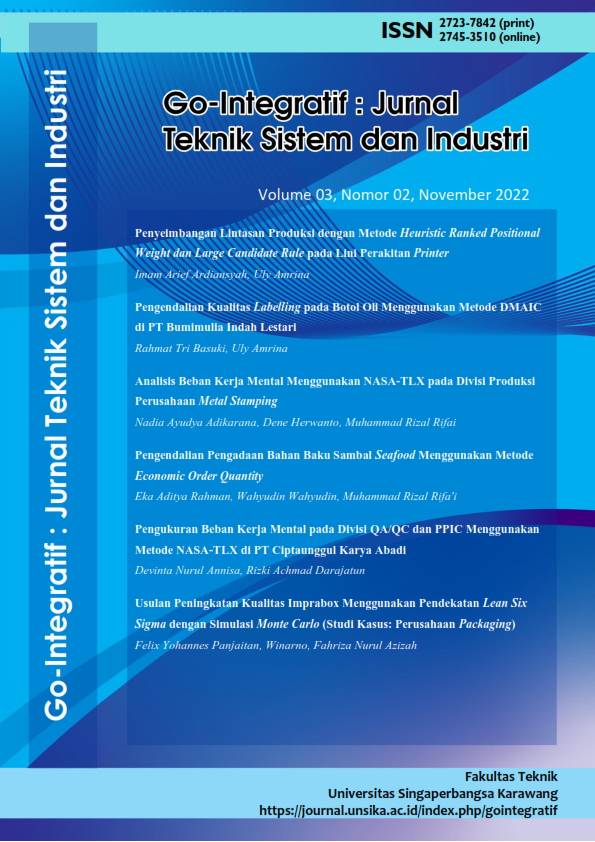Penyeimbangan Lintasan Produksi dengan Metode Heuristic Ranked Positional Weight dan Large Candidate Rule pada Lini Perakitan Printer
DOI:
https://doi.org/10.35261/gijtsi.v3i02.6860Abstract
The mold and metal press work stations line assembly printerThere are several work stations that have a processing time that exceeds the takt time 3.66 minutes. The processing time that exceeds the takt time is at the Cassete 2 and Mechanism 1 work stations with respective times (4.74 minutes) and (4.75 minutes), while the Mechanism 2 work station is the lowest with time (1.2 minutes). . The purpose of this research is to balance the production assembly line the printerResearchers use the Heuristic Ranked Positional Weight (RPW) and Large Candidate Rule (LCR). Comparison of the results of the calculation of path efficiency, smoothing index and balance delay using these two methods shows that the RPW method is the most optimal method. This is indicated by the highest assembly line efficiency value of 89.34%, the balance delay of 10.66%, smoothing index of 5.2785 and the least number of work stations of 13. Thus this will make production run well and smoother than the initial condition.
Keywords: Heuristic; Ranked Positional Weight (RPW); Large Candidate Rule (LCR); Line Efficiency; Balance Delay; Smoothing Index
Downloads
References
M. C. O. Moreira, C. Miralles, and A. M. Costa, “Model and heuristics for the Assembly Line Worker Integration and Balancing Problem,” Comput. Oper. Res., vol. 54, pp. 64–73, Feb. 2015, doi: 10.1016/j.cor.2014.08.021.
I. Kucukkoc and D. Z. Zhang, “Type-E parallel two-sided assembly line balancing problem: Mathematical model and ant colony optimisation based approach with optimised parameters,” Comput. Ind. Eng., vol. 84, pp. 56–69, Jun. 2015, doi: 10.1016/j.cie.2014.12.037.
T. Rachman, “Penentuan Keseimbangan Lintasan Optimal dengan Menggunakan Metode Heuristik,” J. Inovisi, vol. 11, no. 2, pp. 67–83, 2015.
O. E. Great and A. Offiong, “Productivity improvement in Breweries through line balancing using Heuristic method,” Int. J. Eng. Sci. Technol., vol. 5, no. 3, pp. 475–486, 2013.
W. T. Aripin and A. Kurniawan, “Analisis Keseimbangan Lintasan di PT. Cibuniwangi Gunung Satria,” J. Ind. Galuh, vol. 1, no. 2, pp. 48–55, 2019.
I. Ristumadin, “Analisa Produktivitas dan Efisiensi Kerja dengan Line Balancing pada Area Lead Connection di PT A,” J. PASTI, vol. 9, no. 3, pp. 300–310, 2015.
S. Saiful, M. Hambali, and T. M. Rahman, “Penyeimbangan Lintasan Produksi Dengan Metode Heuristik (Studi Kasus PT. XYZ Makassar),” J. Tek. Ind., vol. 15, no. 2, pp. 182–189, Mar. 2016, doi: 10.22219/JTIUMM.Vol15.No2.182-189.
M. S. Khan and P. S. Jha, “Evaluation of Standard Time With the Application of Rank Positional Weighted Method in the Production Line,” Int. J. Mech. Prod., vol. 7, no. 2, pp. 73–80, 2017.
O. Bongomin, J. I. Mwasiagi, E. O. Nganyi, and I. Nibikora, “Improvement of garment assembly line efficiency using line balancing technique,” Eng. Reports, vol. 2, no. 4, Apr. 2020, doi: 10.1002/eng2.12157.
M. Widyantoro, Solihin, R. I. Rosihan, and I. Fajar, “Peningkatan Efisiensi pada Lini Proses Machining Velg Motor dengan Metode Line Balancing PT. XYZ,” J. PASTI, vol. 14, no. 1, pp. 54–64, 2020.
S. J. Ghutukade and S. M. Sawant, “Use of Ranked Position Weighted Method for Assembly Line Balancing,” Int. J. Adv. Eng., vol. 2, no. 4, pp. 83–84, 2013.
Eddy and M. Ahyan, “Optimalisasi Keseimbangan Lintasan Produksi dengan Metode Largest Candidate Rule di PT. PAP,” J. Simetri Rekayasa, vol. 2, no. 2, pp. 76–85, 2020.
Downloads
Published
How to Cite
Issue
Section
License
Copyright (c) 2022 Imam Arief, Uly Amrina

This work is licensed under a Creative Commons Attribution-NonCommercial-ShareAlike 4.0 International License.



